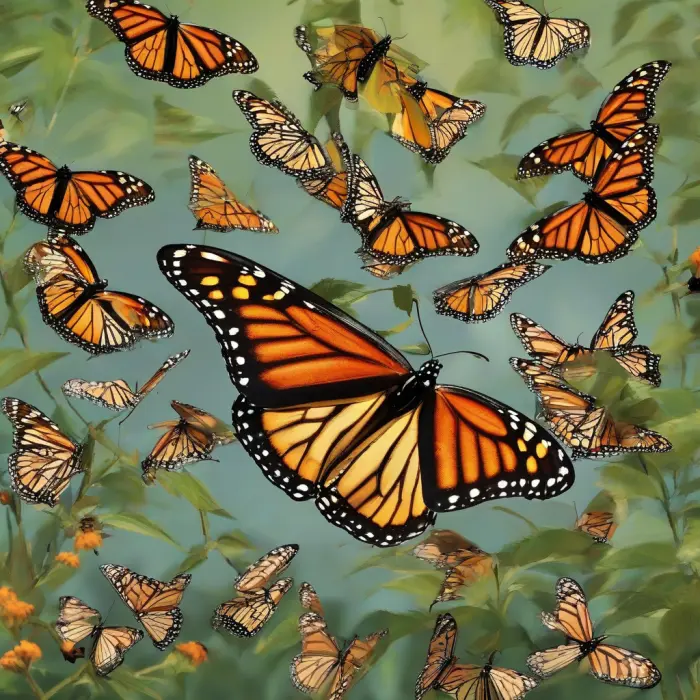Amazing Facts About the Unique Adaptations of Insects
From deserts to glaciers, from forest canopies to city sidewalks, insects thrive thanks to an astonishing toolkit of biological innovations. Here’s a tour of their most remarkable adaptations—and why they matter.
The Exoskeleton: Armor, Waterproofing, and a Built-In Toolbox
The defining feature of insects is their exoskeleton—an external skeleton made of chitin and proteins. This multi-layered armor provides protection, prevents water loss, anchors muscles, and can be sculpted into spines, wings, and mouthparts. Many surfaces are coated with waxes that repel water and reduce desiccation, a crucial advantage on land and in deserts.
Insect cuticle can be incredibly specialized. Dragonfly wings and some cicada wings have nanoscale spikes that can rupture bacterial membranes on contact. Moth eyes sport anti-reflective nanostructures that dramatically cut glare—an adaptation for night flying that has inspired anti-reflective coatings in technology.
Of course, armor limits growth. Insects solve this with molting, shedding the old exoskeleton to expand. Some species undergo complete metamorphosis—transforming from larva to pupa to adult—allowing radically different life stages to exploit different foods and habitats without competing with one another.
Breathing Without Lungs: Tracheae, Spiracles, and Aquatic Tweaks
Insects don’t use lungs. Instead, they breathe through spiracles—tiny openings on the body—connected to a branching network of tracheae that deliver oxygen directly to tissues. Many species actively pump air sacs to ventilate this network during flight or activity.
- Underwater life: Aquatic insects have inventive solutions. Diving beetles ferry an air bubble under their wing covers; water boatmen trap a shimmering bubble on their abdomen; others use a plastron, a thin, permanent air layer held by microscopic hairs that functions like a physical gill.
- Jet-propelled nymphs: Dragonfly nymphs respire with internal rectal gills and can eject water forcefully for a burst of jet propulsion—an underwater escape trick.
Circulation is “open”: instead of blood in vessels under pressure, insects have hemolymph bathing organs. It transports nutrients and immune cells and helps with thermoregulation, while oxygen delivery mostly bypasses it thanks to tracheae.
Eyes and Ears Tuned to an Invisible World
Compound eyes, made of thousands of ommatidia, are superb at detecting motion and change. Many insects see ultraviolet patterns on flowers that humans miss, guiding them to nectar and pollen. Some also detect the polarization of skylight, providing a compass on cloudy days.
- Night stealth: Nocturnal moths often have super-sensitive eyes and anti-reflective eye surfaces to avoid being seen by predators while still seeing well in dim light.
- Hearing in odd places: Insect “ears” (tympanal organs) can be on legs, thorax, or abdomen. Katydids often hear through their forelegs; many moths evolved ultrasonic hearing to detect hunting bats. Some moths even produce clicks that can startle or confuse bat sonar.
- Taste with your feet: Butterflies can taste nectar sources—and the leaves they lay eggs on—using chemosensory hairs on their feet. Antennae also carry dense arrays of receptors for odors and pheromones.
Flight, Leaps, and Elastic Catapults
Insects were the first animals to fly, and they’ve refined the craft in remarkable ways. Many species use asynchronous flight muscles that beat wings faster than nerve signals, storing and releasing energy in the thorax like a spring. Bees hook their fore- and hindwings together with tiny hooks (hamuli) for coordinated flapping. Flies traded their second pair of wings for halteres—gyroscopic clubs that sense body rotation and stabilize agile flight.
- Spring-loaded power: The rubbery protein resilin stores elastic energy. Fleas, froghoppers, and some leafhoppers lock muscles against cuticular springs, then release them for explosive jumps.
- Running on water: Water striders sprint across ponds thanks to superhydrophobic leg hairs and careful distribution of weight that exploits surface tension.
- Speed records: Tiger beetles can run so fast relative to their size that their eyes briefly cannot process the scene, forcing stop-and-go sprints to re-acquire their prey.
Color Without Pigment: Camouflage, Mirrors, and Warning Signals
Insect colors often come from structure, not dye. Microscopic ridges and multilayered scales—like those on Morpho butterflies—interfere with light to create brilliant blues that barely fade. Others are masters of disguise: stick insects mimic twigs, leaf insects resemble leaves down to venation and bite marks, and glasswing butterflies have transparent wings with nano-pillars that reduce reflections.
- Mimicry games: Harmless species may imitate the warning colors of toxic ones (Batesian mimicry), while genuinely harmful species converge on the same pattern (Müllerian mimicry), teaching predators to avoid the look.
- Invisible ink: Flowers often display UV nectar guides that insects see, but humans do not. Likewise, many insects’ cuticles reflect polarized light patterns used in communication and orientation.
Chemical Wizardry: Perfumes, Poisons, and Social Passwords
Insects are chemical engineers. Pheromones coordinate trails, mating, alarm, and aggregation. Social insects carry a colony’s “chemical signature” on their cuticle, allowing nestmates to recognize one another and reject intruders.
- Bombardier beetles: They mix hydrogen peroxide and quinones in a reaction chamber to spray boiling, noxious bursts at predators—pulsed and aimable.
- Venoms and defenses: Bees and wasps deliver injectable venom; some ants spray formic acid; stink bugs release foul odors. Many caterpillars sequester plant toxins, making themselves unpalatable and advertising it with bright colors.
- Biocontrol within: Parasitoid wasps inject eggs along with virus-like particles (polydnaviruses) that disarm host immune systems, a sophisticated alliance encoded in the wasp’s own genome.
Surviving Extremes: Heat Shields, Antifreeze, and Fog Harvesters
Insects push the limits of what life can tolerate.
- Desert brilliance: The Saharan silver ant bears reflective, heat-shedding hairs and runs in the hottest part of the day to avoid predators. Namib Desert beetles collect water from fog on their elytra, where hydrophilic bumps nucleate droplets that roll toward the mouth.
- Cold strategy: Arctic and alpine species load cells with glycerol and specialized antifreeze proteins. Some caterpillars can freeze solid over winter and thaw with spring warmth, resuming life as if paused.
- Thermal startup: Large moths shiver their flight muscles to warm up before takeoff, helping them fly in cool evening air.
Social Superorganisms: Ants, Bees, and Termites
Eusocial insects form societies so integrated they function like single organisms. Queens lay eggs; workers forage, nurse, and defend; soldiers specialize in warfare. Information moves through pheromones, touch, and vibration.
- Engineering feats: Termite mounds act as living lungs, channeling wind and temperature differences to ventilate and regulate humidity for the colony and its farmed fungus.
- Agriculture and antibiotics: Leafcutter ants cultivate fungus gardens and partner with bacteria on their cuticles that produce antibiotics to protect the crop from pathogens.
- Traffic control: Ant trails self-organize: individuals adjust speed and side preferences to avoid jams, a principle used to model human traffic and robotics.
Life Cycles and Reproductive Twists
Metamorphosis partitions life into distinct jobs: larvae eat and grow; adults disperse and reproduce. But there are many twists.
- Telescoping generations: Aphids can reproduce without males (parthenogenesis) and give birth to live young that already contain the next generation—rapid population growth when conditions are good.
- Microbial puppeteers: The bacterium Wolbachia manipulates reproduction in many insects, skewing sex ratios or causing incompatibility that spreads the infection—an adaptation that also makes Wolbachia useful for controlling disease-transmitting mosquitoes.
- Ovipositor tools: Sawflies and wood wasps have drill-like ovipositors to lay eggs in plants; parasitoids use needle-fine ovipositors to reach hidden hosts.
Navigation and Minds on the Move
Despite tiny brains, insects solve complex tasks with elegance.
- Sun compasses and sky maps: Bees use the sun’s position and polarized light patterns to orient, communicating destinations via the famous waggle dance. Desert ants combine skylight cues with step-counting to return home in straight lines.
- Stargazing rollers: Dung beetles navigate in straight paths by referencing the Milky Way on clear nights, ensuring they quickly escape competitors.
- Grand migrations: Monarch butterflies migrate across a continent to overwintering sites they have never seen, guided by a time-compensated sun compass and internal clocks.
Glow in the Dark: Bioluminescence
Fireflies and glow-worms generate light with luciferin-luciferase reactions, controlling oxygen supply to flash in patterns that identify species and signal mates. Some click beetles and larval forms glow continuously, turning darkness into a communication channel.
Record Holders and Oddities
- Loudest insect: Some cicadas reach sound levels over 100 dB at close range—rivaling a chainsaw.
- Longest body length: Certain stick insects measure well over half a meter when legs are included.
- Heaviest insect: Giant wetas can rival small birds in mass, especially gravid females.
- Fastest flyers: Large dragonflies are among the fastest, with agile flight that enables long-distance migration and aerial hunting.
- Best jumper: Froghoppers (spittlebugs) launch many times their body length using catapult-like mechanisms.
Why Insect Adaptations Matter to Us
Insects pollinate crops, recycle nutrients, suppress pests, and feed ecosystems. Their adaptations inspire human technology: anti-reflective coatings from moth eyes, antibacterial surfaces from dragonfly wings, fog-harvesting materials from desert beetles, and swarm algorithms from ants and bees. Understanding insects is not only awe-inspiring—it’s practical for agriculture, conservation, and innovation.










